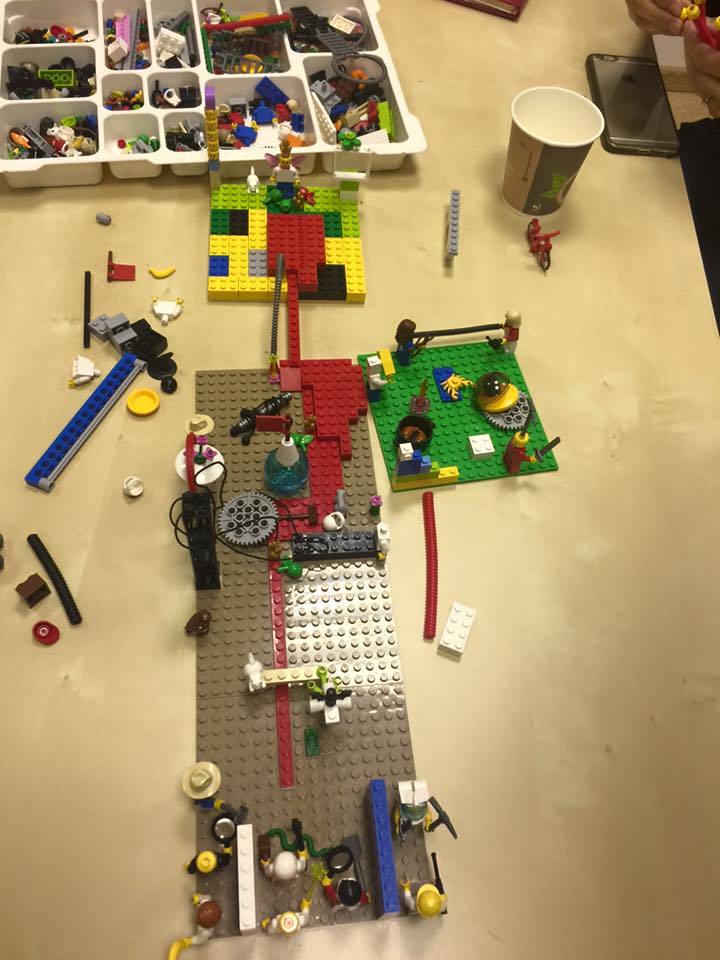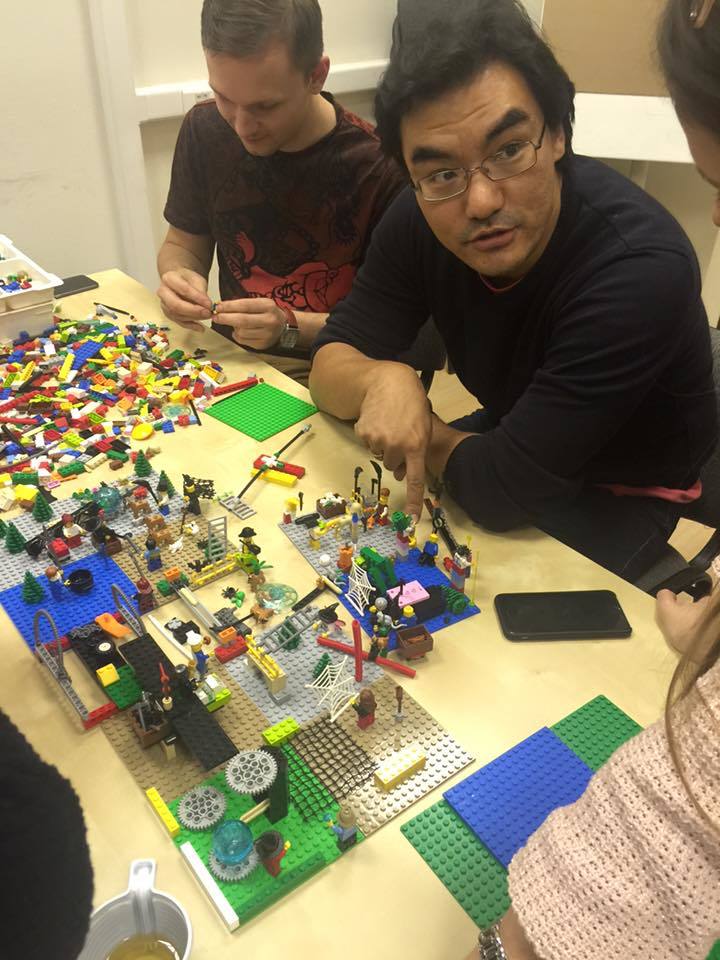Lego Serious Play or “managers play in models”
Lego Serious Play or, in abbreviated form , LSP is an unusual and yet not very common method of game modeling (or - facilitation ). Not confused started? Then we will continue and, we promise - there is nothing difficult in this.
Let us first understand what “facilitation” is.
Speaking in a simple and understandable language, “facilitation” is the organization and holding of effective meetings, where the criterion of effectiveness is the achievement of the stated goal of the meeting at the time specified for this meeting. For example, if we organize a two-hour iteration planning, the facilitator ensures that the team is not distracted by related topics and does not go too deep into detail so that after 2 hours we will have a ready and high-quality plan. Moreover, the quality of the plan implies the involvement of all the participants in the process.
')
Now back to where we started - Lego Serious Play.
The main goal of this method is to stimulate the adoption of non-standard decisions, visualizing them with Lego designer details during sessions of various lengths, the duration of which depends on the complexity of the scope of the meeting and the depth of its development.
In ScrumTrek, this method was recently tested, including for developing a business strategy for the next calendar year (a serious thing), so we will literally tell you firsthand what this beast is and what it looks like.

But first, a little history: Johan Rus and Bart Victor (by the time the method was created, both were professors at the Swiss International Management Development Institute - IMD) came up with the concept of a “serious Lego game” in the mid-90s with one main goal - to stimulate the manager personnel to describe, create and implement their own views on the style and strategy of doing business.
The first experience of applying and testing the concept was carried out by the creators (already mentioned Rus and Victor) with management teams in companies such as Tetra Pak, Hydro Aluminum and TFL, additionally at IMD University (for three hundred employees of Lego itself). Three scientific publications were published: in 1998, the first article, “In Search of Original Strategies: How About a Serious Game?” Was published in the scientific journal of the University IMD; in 1999, “Moving on to the models of creating a strategy based on a serious game”, published in the European Journal Management "and, finally, the industry magazine Long-Range Planning published the most popular article by Matt Statler" Serious strategy games. "
Funny fact - Kjeld Kirk Christiansen, the creator of the designer and the original owner of Lego, initially reacted to this idea with skepticism, but since Rus and Victor were able to quickly prove the applicability of the model in practice, Mr. Christiansen was the first to insist on applying Serious Play to Lego (in the company itself, yes).
Today, quite a few years later, Lego Serious Play is a licensed business consulting technique used not only by Lego itself, Daimler Chrysler, SABMiller, Orange, Nokia, and finally, government organizations are also officially recognizing its effectiveness (for example, The main patent bureau of Denmark). Not so long ago, Lego realized that the development of the method in a closed community was extremely slow and licensed the method under Creative Commons, so now we can safely say that the LSP belongs to everyone.
We finish with the story and tell you more about the method itself, consisting of three key concepts:
A game
A “game” is a process limited by rules and voluntary participation involving the participant’s imagination. The game is also governed by agreements between its participants.Constructionism
Ideas based on the writings of Seymour Papert, who argued that people learn best in the process of getting involved in the game in the process of creating some kind of product that is “external” to themselves: a sand castle, a car, or a computer program.Imagination
Throughout the history of mankind, the term "imagination" was given a lot of interpretations and explanations, the interpretations of which were closely related to the language in which "this was said." In the LSP, “imagination” is assigned the following role: describe something, create, motivate to create.
So, we summarize the most important components of Lego Serious Play.
The method helps to structure: thinking, dialogue and joint decision making.
3-D models of Lego design elements are the basis for: group discussion, exchange of knowledge and experience, decision making.
The main features of the method:
- Full involvement (each build models);
- Self-expression (expressed by everyone);
- Impossibility not to participate (which is very important - “merge” will not work).
In the framework of the LSP technique, two types of sessions are possible: short and long.
Short sessions (3-8 hours) are used primarily for team building, solving a specific problem, creating a common vision and uncovering creative thinking.
Long or “complex” sessions (8-40 hours) are held in the same format broken into pieces and serve primarily to solve problems of strategic and organizational development, forecasting the future, developing new products, discussing / introducing changes and identifying team values or company.
Lego Serious Play declares the following presuppositions: each participant is an expert, everyone should speak out and give feedback to another participant, no one can criticize or try to evaluate models. This is the most natural dialogue that promotes non-standard thinking, where, as fixing objects, there are models from the designer, collected by each participant separately during the “serious game”.
Our coach, Denis Tuchin , answered a few questions regarding the use of Lego Serious Play.
- Denis, what is LSP?
Lego Serious Play, by and large, is a method of facilitation with a couple of cool moments:
1. 100% involvement of all meeting participants;
2. Since the work is tactile (with hands), the fantasy works to the fullest with the help of those parts of our brain that are not involved only in the course of verbal speech.
- Can you tell us a little more about this?
First of all, it is impossible to carry out LSP “as you like” and “anyone” cannot play a serious game. A person should be well aware of what goal he pursues in each particular game.
It begins with an exercise, which is called “to develop a skill” - it is not tied to any specific task, it only demonstrates the work of the method (example below).
Building a model is building a metaphor, by no means a complete copy. Firstly, because different people can have very different copies, so we immediately explain that there is no need to strive for the identity of the real world - just a clear image is enough.
We give a simple example - "Duck". Everyone knows what a duck looks like? Which is a bird. Probably yes. Now imagine that you have a Lego designer.
- Build a duck from 10 parts
- Explain to other participants why your model is a duck.
- Now remove the 5 parts so that the model remains a duck.
Suddenly, isn't it?

Now let's look at the basic principles that guide the participants in this example with a duck (as well as during the construction of other models):
- If you cannot find the part you need, imagine that you have it.
- Do not hold a meeting (including with yourself), DO!
- Your model is your judgment and only you know what they mean (duck and judgments about it)
- Listen with your eyes - watch.
- Enjoy
- How are real, applied tasks solved in the LSP?
There are 4 simple steps:
- The task of collecting the model from the coach
- Model assembly (individually or in a group)
- Explanation of the model
- Questions
At the moment when other participants ask questions for each individual model, in fact, the most interesting thing happens: “Why does the director have a wizard hat?”, “Why does this figure hold a sword when communicating with representatives of other departments?” And so on.
Since a limited time is given to create models and think over a model, and then it is impossible to build, you need to do it right away. The participant first builds, and at the time of explanation, he realizes and interprets what his right hemisphere had in mind. Here the greatest number of insights is born.
However, Lego Serious Play immediately says that it is better to build than to argue. That is, no need to think about what parts you need to build a model - you need to take the existing ones and build.
When building personal models, a huge amount of moments emerges from the field of “psychotherapy”, which should not be forgotten when playing, for example, with colleagues.

- What was your game with colleagues devoted to?
We built a model of the company in the next, 2016, year.
It all started with a model of himself: "To portray yourself and your way into the company."
After that, it was necessary to depict the company itself “as I see it today.”
Finally, the third model - the group, set the goal of the same as the second - “the company at the moment”, but the metaphor itself was built collectively, in parallel by two teams (all employees found a place for them).
The fourth model is “the company in 2016”, it was built individually again. And the fifth is the same, but in a group.
I think you can imagine how much different information we have learned from this. First of all, the difference between “today” and “at the end of next year” carries all the amount of data you need for work planning and employee motivation.
We also built models of “obstacles” that can prevent us from being where we want at the end of next year — this is also extremely interesting. One group built “obstacles” on the current model, that is, these are current tasks / problems and difficulties, and the other group is separate from the model, that is, these are some global tasks and difficulties that need to be addressed.
We also built a model of what is needed to overcome these obstacles (yes, the game is complex), and here an interesting thing happened: the teams that built the models “in” or “separately” from the company's objectives, the solutions built oppositely - that is, the solution models “ the separated “problems” looked like a part of the company, and the models for solving the “connected” (with the company's activities) problems looked like independent solutions.
Thus, we got first, the first steps in what can be done to improve the condition of the company in 2016. We should not forget that the specific models created during the game must be recorded (photo, video, text description). The gurus of the LSP facilitator community say that it is best to take a photo of the model and sign directly on it, which means one or another part of the model.
The ScrumTrek team is very grateful to Nikolai Borisov for his contribution to the preparation and conduct of this session.
Source: https://habr.com/ru/post/296954/
All Articles